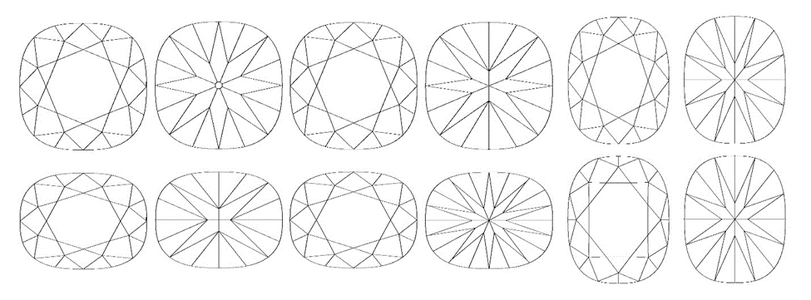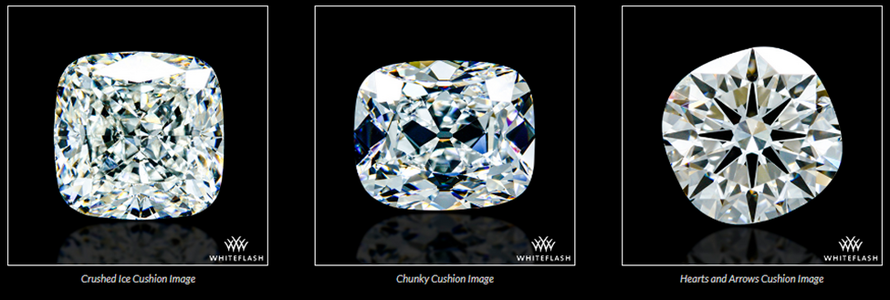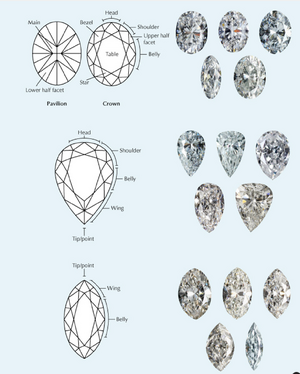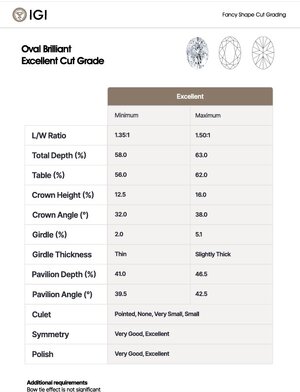- Joined
- Jul 27, 2009
- Messages
- 3,960
IGI Cut Grading - Fancy Shape Diamonds
There is probably no area of diamond grading today that is as inadequate as cut grading of fancy shape diamonds. Reading a laboratory report involves interpreting a number of indirect cues to understand subtle characteristics, but the lack of an overall cut grade is a gaping hole. Cut grading has been done in earnest on round brilliant diamonds since the mid-1990s, having been brought to the forefront of the information age by AGS Laboratories (AGSL), followed a decade later by GIA, and more recently by IGI. When major labs began issuing cut grades, the cut quality of rounds improved significantly, and seemingly overnight. But fancy shape diamond cut grading has proven to be much more complicated, and until recently no laboratory has really made a strong play for this important area of diamond assessment. Consumers have been pretty much on their own to make this critical evaluation, and with potholes such as bowties and windowing along the road to selecting a fancy shape, it’s been a bumpy ride for consumers interested in the diamond shapes gaining popularity today.
The International Gemological Institute (IGI) has been one of the first major labs to attempt to bring more structure to cut grading of fancy shape diamonds, having launched their current system in 2022.

Interest in fancy shape diamonds has significantly increased in recent years, making a reliable cut grading system even more important to the consumer market. The emergence of lab grown diamonds has had a major role in renewed popularity of fancy shapes, and since IGI has been at the forefront of lab grown diamond grading, it makes total sense that they would put focus on developing a cut grading system for fancies.
One of the things that became clear in the research is that fancy shapes cannot be accurately graded by the typical measurements found on a laboratory report, so called parametric grading. As explained on the IGI website, “with fancy shapes, you can’t predict light performance with proportions. Because of this, IGI will use a four-step system that combines recommended proportions with visual assessment.”
As GIA similarly stated in their 2024 research paper , “It is clear that the cut grading methods applied to round brilliants cannot be simply transferred to fancy-shaped diamonds. Each fancy shape merits its own tailored approach to cut quality grading, taking into account its unique set of visual attributes”.
The light performance and face-up appeal of a given fancy shape diamond is determined by the complex interplay of all its facets. Proportions, length to width ratio, specific facet angles and alignment in 3 dimensions, all play an integral part. Thus, only a ray tracing, light performance based system such as that pioneered by AGSL is capable of consistent and repeatable objective results. This requires significant computing power, as well as the development of metrics specific to each shape being graded. And such a system must gain sufficient industry acceptance in terms of how well the grading structure aligns with human observation and preference.
The current IGI system is essentially a hybrid system that involves a parametric component combined with visual assessment by trained graders. IGI publishes their parametric guidelines, which in themselves can be a useful tool for shoppers. It should be noted that IGI states that it is continuing to research and refine fancy cut grading leveraging all available technologies. It is likely that IGI will eventually adopt a light performance approach, at least as a partial solution.
IGI Fancy Shape Cut Grading: Four Step Process
Step 1: Polish and symmetry grading
The first step in the IGI fancy shape grading system is a classic assessment of polish and symmetry; the degree to which all facets have a mirror finish, and the integrity of the outline and degree to which all of the contiguous facets meet at the correct points around the stone. IGI grades are Excellent, Very Good, Good, Fair and Poor. To achieve an overall cut grade of Excellent a fancy shape diamond must receive either Excellent or Very Good on polish and symmetry.
The diamond is then compared against proportion tables consisting of parameters that IGI states are “historically” known to produce the most attractive specimens of the shape being assessed. If proportions are within this range the diamond can potentially receive a grade of Excellent, provided it passes additional evaluation by a trained human grader without a downgrade. In this way, the backstop of the parametric system is human visual confirmation. *A link to download the IGI fancy cut guidelines can be found on this page.
Next step is a visual evaluation by the grader of light return. IGI makes clear that the light return component does not entail an assessment of fire or scintillation. An additional shape-specific evaluation is then conducted to look for issues such as excessive windowing or a pronounced bowtie, which would lower the grade to VG or below. However, IGI provides no specifics about how these determinations are judged. With a heavy reliance on human visual assessment the IGI system is still a relatively subjective and labor intensive one, with trained graders putting eyes on the prize. One would guess that developing a light performance-based ray tracing system would be the ultimate goal for both consistency and scalability.
Currently IGI offers cut grading on fancy shape diamonds submitted to the lab on an optional basis. That is, the submitting entity must request the grade to go onto the report. Since this is a fairly new service, it still remains to be seen how widely adopted the system will be by the trade. There are currently far more fancy shape diamonds in the market with IGI reports that do not have overall cut grade.
The Vexing Complexity of Fancy Shape Diamonds
As mentioned earlier, the light performance and face-up appeal of a fancy shape diamond is driven by complicated interrelationships between facet design, length to width, proportions, and specific facet angles and alignments. The challenge of developing a grading system can probably best be appreciated in the case of cushion cuts. The shape we know as a cushion is really a large family of different facet arrangements that simply share a square or rectangular outline featuring rounded corners. But different variations of the facet structure can result in very different appearances and “flavors”.


Every fancy shape also has multiple facet designs or modifications which can significantly impact their face up appearance. GIA recognizes more than 40 distinct categories of fancy-shaped diamonds; each with unique characteristics and appearance qualities and continuously evolving facet arrangement variations. This not only presents a challenge for parametric and hybrid grading systems, but also for light performance-based systems. Different metrics must be developed not only for different shapes, but for different members of a shape family - because what makes them excellent varies by style. To add to the challenge, there are taste differences and preferences that can even vary by geography.
GIA makes an unequivocal declaration that light performance-based technology is essential for grading fancies: “The much greater number of parameters for fancy shapes precludes any kind of grade prediction based on rounded proportion combinations. Any predictive cut grading for fancy shapes must be based on a 3D representation of the diamond, such as the wireframe files produced by non-contact measuring devices.” Some of the additional parameters that factor into fancy shape cut grading are illustrated below.

Two of the most talked about aspects of fancy shape diamonds are bowties and windowing. Many elongated shapes tend to have a midsection that looks like a bowtie or a horizontal hourglass. If prominent, this feature can have negative impacts for light performance and face-up appeal. In some cases this area of the diamond can reflect too much high angle light and can look very dark when observed at close range because of head shadow. Even if not resulting in too much darkness, a prominent bowtie can give a diamond a disjointed look, as though the ends are separated by the midsection. A well-cut diamond should have a good mix and distribution of virtual facets (the sparkles we see which are more numerous than the physical facets on the diamond). In some cases the juxtaposition of large virtual facets with very small ones can prevent a diamond from displaying a harmonious scintillation pattern when observed in motion.
In the current IGI system, trained graders are making these assessments visually. This introduces an element of subjectivity that will inevitably lead to debate about consistency and repeatability. It is also likely to result in a fairly broad and forgiving assessment of these appearance aspects, in order to incorporate a sufficient range of preferences and tastes.
Conclusion
One of the most important needs in diamond grading today is a reliable system for reporting on cut quality of fancy shape diamonds. The major diamond laboratories and research institutes have been working on this challenge for many years. IGI has recently released their 4 step grading system that combines a parametric component with a dominant human grader assessment.
Both IGI and GIA research have determined that light performance of fancy shapes cannot be accurately predicted by parameters alone. And both are continuing research and development of a fancy cut grading system that employs the latest technologies, which seems likely to evolve into systems with more objective and scientifically sophisticated light performance aspects at their core.
In the meantime, IGI has recently brought the market a useful system. It should help give consumers a better frame of reference on cut quality than currently exists in the market. It remains to be seen how well adopted it will be by the diamond industry. The IGI cut grading service is relatively new and there are far more fancy shape diamonds with IGI reports that do not include an overall cut grade.
*It should be noted that GIA currently is offering, on a limited basis, light performance cut grading utilizing the technologies it acquired from AGS. It is likely that they will roll this system out more broadly in the future.
What is your biggest concern regarding cut grading of fancy shape diamonds? If you have had experience with cut grades issued by IGI what is your opinion of its usefulness?
There is probably no area of diamond grading today that is as inadequate as cut grading of fancy shape diamonds. Reading a laboratory report involves interpreting a number of indirect cues to understand subtle characteristics, but the lack of an overall cut grade is a gaping hole. Cut grading has been done in earnest on round brilliant diamonds since the mid-1990s, having been brought to the forefront of the information age by AGS Laboratories (AGSL), followed a decade later by GIA, and more recently by IGI. When major labs began issuing cut grades, the cut quality of rounds improved significantly, and seemingly overnight. But fancy shape diamond cut grading has proven to be much more complicated, and until recently no laboratory has really made a strong play for this important area of diamond assessment. Consumers have been pretty much on their own to make this critical evaluation, and with potholes such as bowties and windowing along the road to selecting a fancy shape, it’s been a bumpy ride for consumers interested in the diamond shapes gaining popularity today.
The International Gemological Institute (IGI) has been one of the first major labs to attempt to bring more structure to cut grading of fancy shape diamonds, having launched their current system in 2022.

A few of the many non-round "fancy shape" diamonds
BackgroundInterest in fancy shape diamonds has significantly increased in recent years, making a reliable cut grading system even more important to the consumer market. The emergence of lab grown diamonds has had a major role in renewed popularity of fancy shapes, and since IGI has been at the forefront of lab grown diamond grading, it makes total sense that they would put focus on developing a cut grading system for fancies.
One of the things that became clear in the research is that fancy shapes cannot be accurately graded by the typical measurements found on a laboratory report, so called parametric grading. As explained on the IGI website, “with fancy shapes, you can’t predict light performance with proportions. Because of this, IGI will use a four-step system that combines recommended proportions with visual assessment.”
As GIA similarly stated in their 2024 research paper , “It is clear that the cut grading methods applied to round brilliants cannot be simply transferred to fancy-shaped diamonds. Each fancy shape merits its own tailored approach to cut quality grading, taking into account its unique set of visual attributes”.
The light performance and face-up appeal of a given fancy shape diamond is determined by the complex interplay of all its facets. Proportions, length to width ratio, specific facet angles and alignment in 3 dimensions, all play an integral part. Thus, only a ray tracing, light performance based system such as that pioneered by AGSL is capable of consistent and repeatable objective results. This requires significant computing power, as well as the development of metrics specific to each shape being graded. And such a system must gain sufficient industry acceptance in terms of how well the grading structure aligns with human observation and preference.
The current IGI system is essentially a hybrid system that involves a parametric component combined with visual assessment by trained graders. IGI publishes their parametric guidelines, which in themselves can be a useful tool for shoppers. It should be noted that IGI states that it is continuing to research and refine fancy cut grading leveraging all available technologies. It is likely that IGI will eventually adopt a light performance approach, at least as a partial solution.
IGI Fancy Shape Cut Grading: Four Step Process
Step 1: Polish and symmetry grading
- Diamonds earning a minimum of Very Good in both areas become candidates for an overall cut grade of Excellent
- Fancy shape cut quality cannot be graded using proportions (alone) but IGI has published parameters historically observed to produce the most positive beauty components in different shapes
- Diamonds within those parameters remain candidates for Excellent
- IGI has provided these parameters to all diamond producers, in the interest of overall cut quality improvement but do not guarantee Excellent, per steps 3 and 4.
- Shape specific requirements designed to analyze bow-ties, girdle ranges and other factors which vary by shape
- Diamonds meeting these requirements remain candidates for Excellent
- As with color, clarity and finish grading, this assessment is performed by a trained gemologist
- This is not an assessment of fire or scintillation. It is an evaluation of fundamental light behavior, determining whether the diamond returns sufficient light, overall, to be considered top of class, or Excellent, for that shape
- Fancy shaped diamonds which successfully pass the first three steps and have Excellent light return will receive the overall cut grade of Excellent
The first step in the IGI fancy shape grading system is a classic assessment of polish and symmetry; the degree to which all facets have a mirror finish, and the integrity of the outline and degree to which all of the contiguous facets meet at the correct points around the stone. IGI grades are Excellent, Very Good, Good, Fair and Poor. To achieve an overall cut grade of Excellent a fancy shape diamond must receive either Excellent or Very Good on polish and symmetry.
The diamond is then compared against proportion tables consisting of parameters that IGI states are “historically” known to produce the most attractive specimens of the shape being assessed. If proportions are within this range the diamond can potentially receive a grade of Excellent, provided it passes additional evaluation by a trained human grader without a downgrade. In this way, the backstop of the parametric system is human visual confirmation. *A link to download the IGI fancy cut guidelines can be found on this page.
Next step is a visual evaluation by the grader of light return. IGI makes clear that the light return component does not entail an assessment of fire or scintillation. An additional shape-specific evaluation is then conducted to look for issues such as excessive windowing or a pronounced bowtie, which would lower the grade to VG or below. However, IGI provides no specifics about how these determinations are judged. With a heavy reliance on human visual assessment the IGI system is still a relatively subjective and labor intensive one, with trained graders putting eyes on the prize. One would guess that developing a light performance-based ray tracing system would be the ultimate goal for both consistency and scalability.
Currently IGI offers cut grading on fancy shape diamonds submitted to the lab on an optional basis. That is, the submitting entity must request the grade to go onto the report. Since this is a fairly new service, it still remains to be seen how widely adopted the system will be by the trade. There are currently far more fancy shape diamonds in the market with IGI reports that do not have overall cut grade.
The Vexing Complexity of Fancy Shape Diamonds
As mentioned earlier, the light performance and face-up appeal of a fancy shape diamond is driven by complicated interrelationships between facet design, length to width, proportions, and specific facet angles and alignments. The challenge of developing a grading system can probably best be appreciated in the case of cushion cuts. The shape we know as a cushion is really a large family of different facet arrangements that simply share a square or rectangular outline featuring rounded corners. But different variations of the facet structure can result in very different appearances and “flavors”.


Cushion cut in three very different “flavors”
Every fancy shape also has multiple facet designs or modifications which can significantly impact their face up appearance. GIA recognizes more than 40 distinct categories of fancy-shaped diamonds; each with unique characteristics and appearance qualities and continuously evolving facet arrangement variations. This not only presents a challenge for parametric and hybrid grading systems, but also for light performance-based systems. Different metrics must be developed not only for different shapes, but for different members of a shape family - because what makes them excellent varies by style. To add to the challenge, there are taste differences and preferences that can even vary by geography.
GIA makes an unequivocal declaration that light performance-based technology is essential for grading fancies: “The much greater number of parameters for fancy shapes precludes any kind of grade prediction based on rounded proportion combinations. Any predictive cut grading for fancy shapes must be based on a 3D representation of the diamond, such as the wireframe files produced by non-contact measuring devices.” Some of the additional parameters that factor into fancy shape cut grading are illustrated below.

Photo courtesy of GIA
Bowties and WindowingTwo of the most talked about aspects of fancy shape diamonds are bowties and windowing. Many elongated shapes tend to have a midsection that looks like a bowtie or a horizontal hourglass. If prominent, this feature can have negative impacts for light performance and face-up appeal. In some cases this area of the diamond can reflect too much high angle light and can look very dark when observed at close range because of head shadow. Even if not resulting in too much darkness, a prominent bowtie can give a diamond a disjointed look, as though the ends are separated by the midsection. A well-cut diamond should have a good mix and distribution of virtual facets (the sparkles we see which are more numerous than the physical facets on the diamond). In some cases the juxtaposition of large virtual facets with very small ones can prevent a diamond from displaying a harmonious scintillation pattern when observed in motion.
In the current IGI system, trained graders are making these assessments visually. This introduces an element of subjectivity that will inevitably lead to debate about consistency and repeatability. It is also likely to result in a fairly broad and forgiving assessment of these appearance aspects, in order to incorporate a sufficient range of preferences and tastes.
Conclusion
One of the most important needs in diamond grading today is a reliable system for reporting on cut quality of fancy shape diamonds. The major diamond laboratories and research institutes have been working on this challenge for many years. IGI has recently released their 4 step grading system that combines a parametric component with a dominant human grader assessment.
Both IGI and GIA research have determined that light performance of fancy shapes cannot be accurately predicted by parameters alone. And both are continuing research and development of a fancy cut grading system that employs the latest technologies, which seems likely to evolve into systems with more objective and scientifically sophisticated light performance aspects at their core.
In the meantime, IGI has recently brought the market a useful system. It should help give consumers a better frame of reference on cut quality than currently exists in the market. It remains to be seen how well adopted it will be by the diamond industry. The IGI cut grading service is relatively new and there are far more fancy shape diamonds with IGI reports that do not include an overall cut grade.
*It should be noted that GIA currently is offering, on a limited basis, light performance cut grading utilizing the technologies it acquired from AGS. It is likely that they will roll this system out more broadly in the future.
What is your biggest concern regarding cut grading of fancy shape diamonds? If you have had experience with cut grades issued by IGI what is your opinion of its usefulness?
Attachments
Last edited:





300x240.png)